Algorithms/Methods
Polarymetric waves sensing, aided by Machine Learning
System for Polarymetric remote sensing of water waves, where the special camera equipped with linear polarization filters is used as the main sensor. The local slopes of water waves are inferred by the level of polarization in each location. The system is solving this complex problem using Machine Learning methods, using simple monochromatic waves as training sets for Neural Networks. The trained networks are capable to produce measurements of spatio-temporal slope and surface elvation maps of irregular (spectral) waves.
Ginio, N., Liberzon, D., Lindenbaum, M., & Fishbain, B. (2023). Efficient machine learning method for spatio-temporal water surface waves reconstruction from polarimetric images. Measurement Science and Technology, 34(5), 055801. https://doi.org/10.1088/1361-6501/acb3eb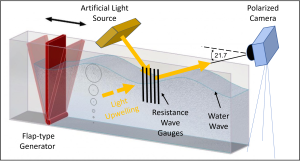
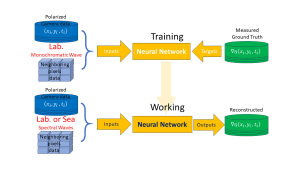
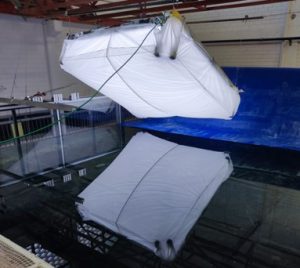
Breaking waves detection
Provides accurate detection (above 90% positive detection rate) of breaking wave crests in data of the instantaneous water surface elevation fluctuations as obtained by simple wave gauges. Does not require water surface imaging (i.e. not whitecap counting). Suitable for application in wide variety of waves fields, as the algorithm parameters can be adjusted in correspondence with the analyzed waves field parameters (mean waves period, sampling frequency, etc.).
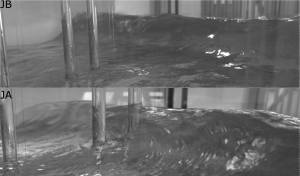
Detection of breaking waves is achieved by analyzing the signal of the waves instantaneous frequency variations (obtained by means of Hilbert transform). Patterns of the frequency variations associated with the breaking crests are identified using wavelets transform based pattern recognition algorithm.
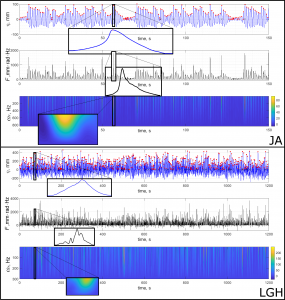
Full method description is provided here (please don’t forget to cite):
The algorithm is implemented in Matlab, and requires WaveletsAnalyzer Toolbox/App.
Extract all the files/functions from the archive into one folder and open the DetectBreakersEnsemble.m function. Read the instructions in the function header, and adjust the parameters in the first cell of the function before execution. F2 and F3 pattern mother-wavelets provide the best results.
Note: This algorithm is beta and the author will thank the users for any comments, corrections and recommendations. It is made freely available for the use in scientific research, educational purposes and modeling.Please cite the mentioned above paper.
Golf of Aqaba (Eilat) – wind waves observations
About 50 hours long measurements of the waves field and wind during June 2017 at the Eilat Inter University Institute for Marine Sciences, Israel.
The data set is freely distributed using the Mendely Data service.
Get the data set here: dx.doi.org/10.17632/kgx4559c67.2
It includes measurements of the water surface instantaneous fluctuations, water depth variations (tidal waves), wind flow velocity mean and fluctuating values. Waves measurements were made in spatial array of 5 wave gauges, allowing derivation of the waves energy propagation direction and directional spread. This data set is highly suitable for education purposes, for classes on water waves, environmental flows, wind turbulence, spectral analysis, statistical properties of time series, and more.
Full description and examples for data processing techniques and the results are published here:
Anabatic (upslope) turbulent flows – Nofit field experiment and water tank physical model
The complete dataset of anabatic (upslope) wind velocity fluctuations measured using the recently developed sonic-hot-film collocated anemometer (two X-shaped hot films were used in this field measurement). The measurements took place on a moderate slope in Nofit, Israel during August 2015. The dataset is uploaded along with an automated detection algorithm (Matlab code) to capture the beginning and ending times of a bursting event observed in the flow. The data and the complete detection algorithm procedure are detailed in:
Hilel Goldshmid, R., & Liberzon, D. (2020). Obtaining turbulence statistics of thermally driven anabatic flow by sonic-hot-film combo anemometer. Environmental Fluid Mechanics, 20(5), 1221–1249. https://doi.org/10.1007/s10652-018-9649-x
Goldshmid, R. H., & Liberzon, D. (2020). Automated identification and characterization method of turbulent bursting from single-point records of the velocity field. Measurement Science and Technology, 31(10), 105801. https://doi.org/10.1088/1361-6501/ab912b
The water tank physical model was later used to stage controlled experiemnts of thermally driven up-slope flows, discovering the 3D nature and intermittency of the developing turbulent boundary layer.

Goldshmid, R. H., & Liberzon, D. (2023). Laboratory investigation of nominally two-dimensional anabatic flow on symmetric double slopes. Physics of Fluids, 35(11). https://doi.org/10.1063/5.0164984